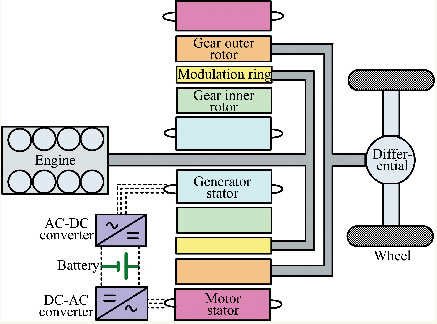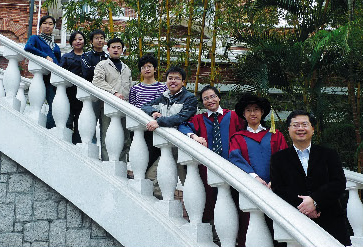With
ever increasing concern on energy efficiency and environmental
protection, there is fast-growing interest in hybrid electric vehicles
(HEVs). Differing from battery powered electric vehicles, HEVs involve
two energy sources, namely the gasoline and the battery, as well as two
propulsion devices, namely the engine and the motor. Hence, they take
the definite advantages that they can offer a much longer driving range
and be easily refueled at existing gas stations. Their key challenge is
how to effectively combine the engine driving force and the motor
driving force in such a way that the engine can always operate at its
optimal efficiency and produce the minimum tailpipe exhaust. The
existing HEVs essentially adopt the same technology, termed the
planetary-geared electronic-continuously variable transmission (E-CVT)
propulsion system, to combine the engine driving force and the motor
driving force. However, this system suffers from the drawbacks of low
power density, high transmission loss, wear-and-tear problem and annoying audible noise.
Rather than using physical contacts to perform force transmission as
adopted by mechanical gears, magnetic gears can transmit the force
using contactless magnetic attraction. The use of coaxial arrangement
can further enable magnetic gears to simultaneously utilize all magnets
for force transmission. By purposely designing the modulating ring of
the magnetic gear to be rotatable, it can work as the planetary gear
for power splitting. Namely, the engine power flow can be split into
two paths – one path is via the outer rotor of the magnetic gear
(shared with the rotor of the motor) while another path is via the
inner rotor of the magnetic gear (shared with the rotor of the
generator). The corresponding power flow is controlled by using two
back-to-back converters separately coupled to the stators of the motor
and the generator. Increasingly, both the motor and the generator can
be integrated into the magnetic gear to form a single machine unit. By
artfully controlling the converters to perform power splitting,
effective E-CVT propulsion can be achieved.

Principle of magnetic-geared electronic-continuously variable transmission propulsion system for hybrid electric vehicles
|
|
 Research group
Research group
This
magnetic-geared E-CVT propulsion system can fundamentally solve all key
drawbacks of the existing E-CVT systems for HEVs, thus offering high
power density, high transmission efficiency and quiet operation. By
electronically controlling this system, the engine can always operate
along its optimal operating line at which its fuel consumption is
minimized throughout the whole operating range. Hence, the overall
energy efficiency of HEVs can be improved while their tailpipe exhaust
can be further reduced. Additionally, this system enables the use of
one-side-in and one-side-out structure which can eliminate the bulky
and lossy silent chain employed in the existing E-CVT systems.
Limited
by the unsatisfactory performance
of rechargeable batteries and the high cost of fuel cells, HEVs have
been identified as the best choice to bridge the current situation and
the demand for clean and energy efficient road transportation. The
proposed E-CVT system possesses the definite merit of higher
energy efficiency than the existing ones, which can further
reduce the oil
consumption and the exhaust emission due to road transportation.
Moreover, its another definite merit of higher power density can
facilitate the design of HEVs with smaller size and lighter weight,
which are vitally important for extending their full-electric
zero-emission driving range.
Prof K.T. Chau
Department of Electrical and Electronic
Engineering
The University of Hong Kong
ktchau@eee.hku.hk
|
